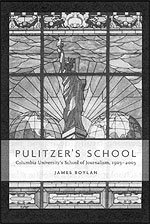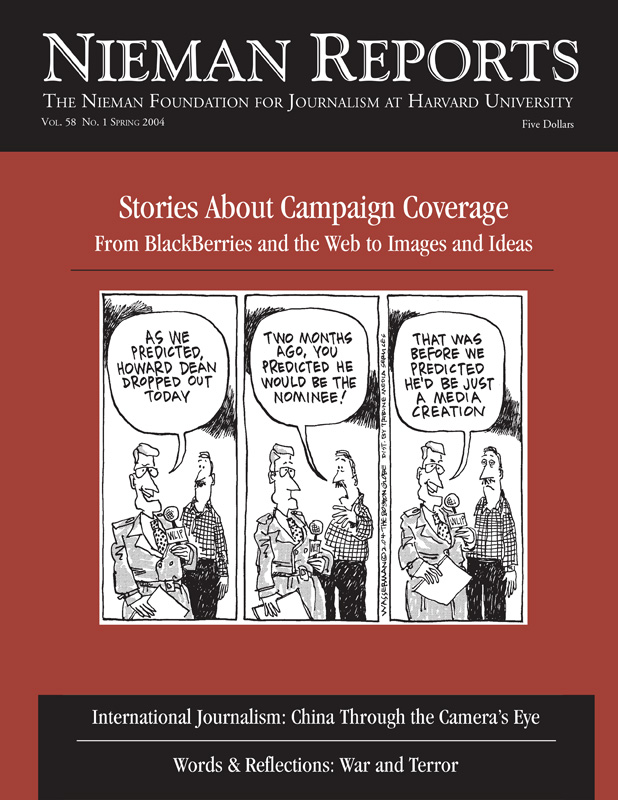 Pulitzer’s School: Columbia University’s School of Journalism, 1903-2003
Pulitzer’s School: Columbia University’s School of Journalism, 1903-2003
James Boylan
Columbia University Press. 337 Pages. $37.50.
A century ago, Joseph Pulitzer had a grand idea: to establish a school of journalism. And not just anywhere, but at Columbia University in New York, coupling a great center of learning with a vast urban laboratory for the gathering of news. Pulitzer, the publisher of the New York World, boldly conceived that such a school might help elevate journalism to the status of professions such as business and law. But in order to house it on Columbia’s expansive new uptown campus—in fact, right by the main gate at 116th Street and Broadway—he had to deal with an equally ambitious university president, Nicholas Murray Butler, then at the beginning of his 43-year tenure.
It wasn’t easy. After envisioning a “School of Journalism” in a now-land-mark essay that appeared in the North American Review in 1904, it took several years for Pulitzer to sell the idea to Butler and for their two outsized egos to come to terms. In the end, Pulitzer decided the school shouldn’t be launched until his death, and so the Columbia School of Journalism finally opened its doors in 1912. By then, the University of Missouri had beaten Columbia for the honor of being the first school of journalism in America.
What exactly did Pulitzer have in mind? This is what he wrote: “It is the idea of work for the community, not commerce, not for one’s self, but primarily for the public, that needs to be taught. The School of Journalism is to be, in my conception, not only not commercial, but anticommercial.” That suggests an interesting idea: that in a democracy, journalism, like education, is too important to be left to the private sector.
The J-School’s History
But only now, a century after it was articulated, is the school edging back toward Pulitzer’s vision. And what a tortuous century it has been. That’s one of the many ironies underscored in “Pulitzer’s School,” James Boylan’s well-timed history of the “J-School.” Indeed, the title itself is an ironic reflection of how the school, after failing to take its founder’s name, suffered the indignity of being overshadowed by (despite close cohabitation with) the Pulitzer Prizes.
Boylan, who taught at the school from 1957 to 1979, was founding editor of the Columbia Journalism Review—perhaps the school’s most palpable achievement. Richard T. Baker wrote a history of the school in 1954, but a fuller treatment was overdue, and “Pulitzer’s School” is a balanced, meticulous book, and a service to the troubled and problematic cause of journalism education.
A year after opening for business under its imperious first director, Talcott Williams, the School of Journalism moved into its present building on 116th Street. It was beset with contradictions from the outset. The original plan was for a four-year undergraduate liberal arts curriculum to prepare students for the practice of journalism. But by 1919 it had evolved into a two-year course for upperclassmen. Already it was beginning to look like a trade school and loosen its ties to the university at large. The relationship with Columbia’s administration has been contentious ever since.
The journalism school’s pretensions were mocked by the likes of H.L. Mencken and A.J. Liebling, among many other critics, yet it gained prestige. A supposed center of enlightened journalism, it reflected the antipacifism and anti-Semitism of the university during the First World War. Almost from the first, it was fraught with uncertainty about what exactly it should teach, what degree it should award, and whether it should focus on general knowledge or the practice of journalism: the high-minded vision of its all-but-irrelevant founder, or the more mundane predilections of the press.
The first and most durable dean, serving from 1931 to 1956, was Carl W. Ackerman, a talented and ambitious leader who brought the school to greater prominence but neglected the curriculum. His major innovation was the conversion to a one-year graduate program in 1935. The school’s core mission became fixed: to provide a graduate year of journalistic work on the simulated-newsroom model. The (New York) Daily News commented tartly: “We consider that a step in the right direction, but believe that the course is still one year too long.”
That model has been questioned and criticized ever since: Why should “knowledge of the craft” be taught at a major university? Why should it be taught at the expense of the vast array of learning that the university has to offer, much of it relevant to developing good journalists? And why should it be taught at all, when it can be learned by on-the-job experience at smaller newspapers and broadcast stations?
Much of the history that Boylan relates is of institutional drift and infighting among faculty, deans and presidents. There was a somewhat bizarre sideshow during World War II, when the school sponsored a satellite school of journalism in Chungking, China under the auspices of Chiang Kai-shek’s ministry of propaganda, with secret sponsorship by the Office of Strategic Services, the wartime forerunner of the Central Intelligence Agency. It lasted two years, producing a rich assortment of conflicts and a heavily censored newspaper. The account of that dubious enterprise is one of the more entertaining parts of the book.
Ackerman was thwarted in seeking a two-year graduate program, but the conversion to a graduate school was surely justified: If nothing else, journalists should have a liberal arts education before undertaking professional training. His final act was perhaps his best: standing up to McCarthyism when many in the university did not.
A string of able and dedicated deans succeeded Ackerman without fundamentally altering the school. During the 1950’s and 60’s, Edward Barrett enriched the curriculum, but he, too, failed in the effort to add an additional year. In more recent decades, Elie Abel, Osborn Elliott, Joan Konner, and Tom Goldstein were caught up in the perennial conflicts with the faculty (increasingly capable but resistant to the scholarly model), the university administration, and the other tenants of the Journalism Building on 116th Street. Those media organizations—including the American Press Institute, the Gannett Foundation’s Media Studies Center, and the Pulitzer Prizes—were often hostile to the school despite their natural affinities to journalism education. Only in 1995 did the school gain full control of its building.
“Pulitzer’s School” often reads like a textbook of academic politics at its worst. But Boylan also notes the brighter side of the ledger. That Columbia’s School of Journalism has survived at all despite its weaknesses, its critics, and slim support from the university, is something of a marvel. It has enjoyed a national and international reputation that many of those critics consider outsized. And it has a deeply devoted following among its alumni/ae, particularly those who are working journalists.
Moreover, the school has attracted distinguished faculty members through much of its curious career, including such scholars as Douglas Southall Freeman, Walter B. Pitkin and Henry Pringle in the early decades, and in later years the likes of Fred Friendly, Melvin Mencher, Penn Kimball, and Kenneth K. Goldstein. (Each of the latter, and Goldstein in particular, managed to inspire this wayward reviewer.) And in the past decade, two top-notch media scholars have been added, James W. Carey and Todd Gitlin.
Returning to Pulitzer’s Vision
The final chapter of “Pulitzer’s School” recounts the recent dramatic events at the J-School: how Lee C. Bollinger, newly installed in 2002 as Columbia’s president, abruptly called off the search for a new journalism dean, created an elite task force to contemplate the mission of journalism education and, in 2003, selected Nicholas Lemann to lead the school. Late in 2003, it was announced that a two-year program would begin on a small scale, to further augment the reporting curriculum with substantive scholarship. Perhaps Pulitzer’s dream of training thoughtful, knowledgeable journalists will finally be realized.
Boylan’s history of the school is full of ironic subtext: how it drifted from Pulitzer’s vision to become a trade school; how it missed the chance to carry his name; its uncertainty and mediocrity, especially early on, despite being the sole journalism school on an Ivy League campus and widely considered the nation’s best; its failure to successfully meld with that university, and the recent shift back toward Pulitzer’s vision of teaching knowledge as well as skills.
Ultimately, “Pulitzer’s School” is about a basic and corrosive cultural rift. It’s not just the various cultural and intellectual barriers between professors and journalists, although that looms large; many fine minds have passed through schools of journalism, as teachers and students. It is the wider failure of American culture to reconcile journalism and academe as broad—and ultimately connected—avenues for inquiry and pursuit of truth in the service of democracy. Columbia now has an opportunity to contribute to such a reconciliation. Bollinger and Lemann will attempt, where so many have failed, to bring scholarship and journalism together for the public good. “Pulitzer’s School” is an excellent preface to that great enterprise.
Jeffrey Scheuer, a 1978 graduate of Columbia’s Graduate School of Journalism, is the author of “The Sound Bite Society: How Television Helps the Right and Hurts the Left,” published by Four Walls Eight Windows in 1999 and Routledge in 2001. He is writing a book on journalism and democracy.



